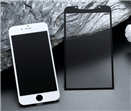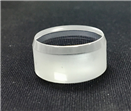

Time:2025-05-09
Sapphire high-strength glass, as a material with unique physical properties, has demonstrated enormous potential and value in multiple high-tech and industrial fields. One of its notable features is high thermal stability, which enables it to effectively dissipate heat and prevent performance degradation caused by temperature changes. This article will explore its high thermal stability, as well as its applications and advantages in multiple fields.
The high thermal stability of sapphire high-strength glass comes from its unique material composition and crystal structure. Sapphire glass based on aluminum oxide (Al ? O3) has a high melting point and excellent thermal conductivity. Its melting point is as high as 2040 degrees Celsius, which means that sapphire glass can still remain solid in high temperature environments without deformation or melting. Meanwhile, the thermal conductivity of sapphire glass is also considerable, reaching 42W/m · K at room temperature, which is much higher than that of ordinary glass and other common materials. High thermal conductivity enables sapphire glass to quickly dissipate heat, effectively preventing performance degradation caused by heat accumulation.

The high thermal stability provides a solid foundation for the application of sapphire high-strength glass in multiple fields. In the field of consumer electronics, with the popularity of devices such as smartphones and tablets, consumers have increasingly high requirements for product durability and aesthetics. Sapphire high-strength glass has become an important choice for manufacturing components such as mobile phone screens and watch mirrors due to its high hardness, wear resistance, and scratch resistance, and its high thermal stability further enhances the reliability of these products. When a mobile phone is used for a long time, such as watching videos, playing games, or performing high-intensity calculations, it will generate a large amount of heat. If the screen material cannot effectively dissipate heat, it will lead to a decrease in screen performance and even affect the service life of the entire device. With its high thermal stability, it can effectively dissipate this heat, maintaining the stability and clarity of the screen, thereby enhancing the user experience.
In the field of optics, high thermal stability and high transparency make it a material for manufacturing high-precision optical components. Camera lenses, telescope lenses, lasers, and other equipment require high transparency and thermal stability of materials. The refractive index range of sapphire glass is between 1.75 and 1.77, which endows it with high transparency and optical clarity. Meanwhile, its low absorption coefficient ensures minimal loss of light during transmission within the material. This enables sapphire glass to provide clearer and more accurate images when manufacturing high-precision optical components. In addition, high thermal stability enables sapphire glass to maintain dimensional stability under harsh temperature conditions, which is beneficial for optical system calibration and long-term use.
In addition to high thermal stability, sapphire high-strength glass also has a series of other excellent physical properties. Its hardness reaches 9.0 Mohs hardness, which makes it almost resistant to daily wear and most tool scratches. This feature gives it a significant advantage in manufacturing parts that require high wear resistance, such as watch mirrors and smartphone screens. At the same time, its crystal density is 3.98g/cm ³, much higher than that of ordinary glass, which means its molecular structure is more compact, giving the material higher strength and better stability. The tight molecular structure also helps reduce light scattering inside the material, improving transparency and clarity.
In terms of electrical performance, sapphire high-strength glass also has unique advantages. As an insulating material, it has low conductivity and is suitable for electrical insulation applications. Meanwhile, its piezoelectric properties enable it to generate charges in response to mechanical stress, thus playing an important role in sensors and converters. This characteristic makes it have broad application prospects in the fields of electronic devices and sensor manufacturing.
Sapphire high-strength glass has shown great potential and value in many high-tech and industrial fields due to its unique advantages such as high thermal stability, high hardness, high transparency, good chemical stability, and electrical properties. Both consumer electronics and optical devices bring more convenient, efficient, and secure solutions to life and production due to their unique physical characteristics.






Tel
Mobile phone
Customer service
TOP